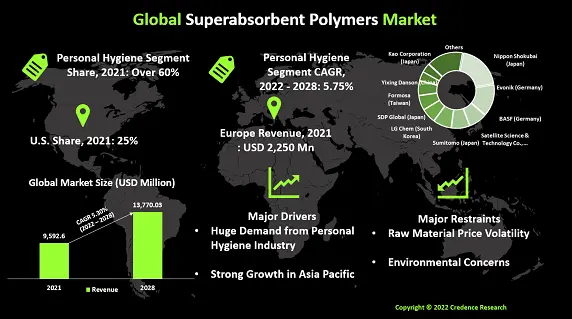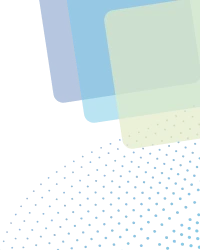1. Preface
1.1. Report Description
1.1.1. Purpose of the Report
1.1.2. Target Audience
1.1.3. USP and Key Offerings
1.2. Research Scope_Toc507161964
1.3. Research Methodology
1.3.1. Phase I – Secondary Research
1.3.2. Phase II – Primary Research
1.3.3. Phase III – Expert Panel Review
1.3.4. Approach Adopted
1.3.4.1. Top-Down Approach
1.3.4.2. Bottom-Up Approach
1.3.5. Assumptions
1.4. Market Segmentation
2. Executive Summary
2.1. Market Snapshot: Global Superabsorbent Polymers Market
3. Market Dynamics & Factors Analysis
3.1. Introduction
3.1.1. Global Superabsorbent Polymers Market Value, 2016-2028, (US$ Bn)
3.2. Market Dynamics
3.2.1. Key Growth Trends
3.2.2. Major Industry Challenges
3.2.3. Key Growth Pockets
3.3. Attractive Investment Proposition,2021
3.3.1. Type
3.3.2. Application
3.3.3. Geography
3.4. Porter’s Five Forces Analysis
3.4.1. Threat of New Entrants
3.4.2. Bargaining Power of Buyers/Consumers
3.4.3. Bargaining Power of Suppliers
3.4.4. Threat of Substitute Types
3.4.5. Intensity of Competitive Rivalry
3.5. Value Chain Analysis
4. Market Positioning of Key Players, 2021
4.1. Company market share of key players, 2021
4.2. Top 6 Players
4.3. Top 3 Players
4.4. Major Strategies Adopted by Key Players
5. COVID 19 Impact Analysis
5.1. Global Superabsorbent Polymers Market Pre Vs Post COVID 19, 2019 – 2028
5.2. Impact on Import & Export
5.3. Impact on Demand & Supply
6. North America
6.1. North America Superabsorbent Polymers Market, by Country, 2016-2028(US$ Bn)
6.1.1. U.S.
6.1.2. Canada
6.1.3. Mexico
6.2. North America Superabsorbent Polymers Market, by Type, 2016-2028(US$ Bn)
6.2.1. Overview
6.2.2. Sodium Polyacrylate
6.2.3. Polyacrylate/Polyacrylamide, Copolymers
6.2.4. Others
6.3. North America Superabsorbent Polymers Market, by Application, 2016-2028(US$ Bn)
6.3.1. Overview
6.3.2. Personal Hygiene
6.3.3. men
6.3.4. Industrial
6.3.5. Medical
6.3.6. Others
7. Europe
7.1. Europe Superabsorbent Polymers Market, by Country, 2016-2028(US$ Bn)
7.1.1. UK
7.1.2. France
7.1.3. Germany
7.1.4. Italy
7.1.5. Russia
7.1.6. Ukraine
7.1.7. Spain
7.1.8. Belgium
7.1.9. Netherland
7.1.10. Austria
7.1.11. Sweden
7.1.12. Poland
7.1.13. Denmark
7.1.14. Switzerland
7.1.15. Rest of Europe
7.2. Europe Superabsorbent Polymers Market, by Type, 2016-2028(US$ Bn)
7.2.1. Overview
7.2.2. Sodium Polyacrylate
7.2.3. Polyacrylate/Polyacrylamide, Copolymers
7.2.4. Others
7.3. Europe Superabsorbent Polymers Market, by Application, 2016-2028(US$ Bn)
7.3.1. Overview
7.3.2. Personal Hygiene
7.3.3. men
7.3.4. Industrial
7.3.5. Medical
7.3.6. Others
8. Asia Pacific
8.1. Asia Pacific Superabsorbent Polymers Market, by Country, 2016-2028(US$ Bn)
8.1.1. China
8.1.2. Japan
8.1.3. South Korea
8.1.4. India
8.1.5. Australia
8.1.6. New Zealand
8.1.7. Taiwan
8.1.8. Indonesia
8.1.9. Malaysia
8.1.10. Philippine
8.1.11. Rest of Asia Pacific
8.2. Asia Pacific Superabsorbent Polymers Market, by Type, 2016-2028(US$ Bn)
8.2.1. Overview
8.2.2. Sodium Polyacrylate
8.2.3. Polyacrylate/Polyacrylamide, Copolymers
8.2.4. Others
8.3. Asia Pacific Superabsorbent Polymers Market, by Application, 2016-2028(US$ Bn)
8.3.1. Overview
8.3.2. Personal Hygiene
8.3.3. men
8.3.4. Industrial
8.3.5. Medical
8.3.6. Others
9. Latin America
9.1. Latin America Superabsorbent Polymers Market, by Country, 2016-2028(US$ Bn)
9.1.1. Brazil
9.1.2. Argentina
9.1.3. Peru
9.1.4. Chile
9.1.5. Colombia
9.1.6. Rest of Latin America
9.2. Latin America Superabsorbent Polymers Market, by Type, 2016-2028(US$ Bn)
9.2.1. Overview
9.2.2. Sodium Polyacrylate
9.2.3. Polyacrylate/Polyacrylamide, Copolymers
9.2.4. Others
9.3. Latin America Superabsorbent Polymers Market, by Application, 2016-2028(US$ Bn)
9.3.1. Overview
9.3.2. Personal Hygiene
9.3.3. men
9.3.4. Industrial
9.3.5. Medical
9.3.6. Others
10. Middle East
10.1. Middle East Superabsorbent Polymers Market, by Country, 2016-2028(US$ Bn)
10.1.1. UAE
10.1.2.
10.1.3. KSA
10.1.4. Israel
10.1.5. Turkey
10.1.6. Iran
10.1.7. Rest of Middle East
10.2. Middle East Superabsorbent Polymers Market, by Type, 2016-2028(US$ Bn)
10.2.1. Overview
10.2.2. Sodium Polyacrylate
10.2.3. Polyacrylate/Polyacrylamide, Copolymers
10.2.4. Others
10.3. Middle East Superabsorbent Polymers Market, by Application, 2016-2028(US$ Bn)
10.3.1. Overview
10.3.2. Personal Hygiene
10.3.3. men
10.3.4. Industrial
10.3.5. Medical
10.3.6. Others
11. Africa
11.1. Africa Superabsorbent Polymers Market, by Country, 2016-2028(US$ Bn)
11.1.1. South Africa
11.1.2. Egypt
11.1.3. Nigeria
11.1.4. Rest of Africa
11.2. Africa Superabsorbent Polymers Market, by Type, 2016-2028(US$ Bn)
11.2.1. Overview
11.2.2. Sodium Polyacrylate
11.2.3. Polyacrylate/Polyacrylamide, Copolymers
11.2.4. Others
11.3. Africa Superabsorbent Polymers Market, by Application, 2016-2028(US$ Bn)
11.3.1. Overview
11.3.2. Personal Hygiene
11.3.3. men
11.3.4. Industrial
11.3.5. Medical
11.3.6. Others
12. Global
12.1. Global Superabsorbent Polymers Market, by Type, 2016-2028(US$ Bn)
12.1.1. Overview
12.1.2. Sodium Polyacrylate
12.1.3. Polyacrylate/Polyacrylamide, Copolymers
12.1.4. Others
12.2. Global Superabsorbent Polymers Market, by Application, 2016-2028(US$ Bn)
12.2.1. Overview
12.2.2. Personal Hygiene
12.2.3. men
12.2.4. Industrial
12.2.5. Medical
12.2.6. Others
13. Company Profiles
13.1. Nippon Shokubai (Japan)
13.2. Evonik (Germany)
13.3. BASF (Germany)
13.4. Satellite Science & Technology Co., Ltd.(China)
13.5. Sumitomo (Japan)
13.6. LG Chem (South Korea)
13.7. SDP Global (Japan)
13.8. Formosa (Taiwan)
13.9. Yixing Danson (China)
13.10. Kao Corporation (Japan)
13.11. Others
List of Figures
FIG. 1 Global Superabsorbent Polymers Market: Research Methodology
FIG. 2 Market Size Estimation – Top Down & Bottom up Approach
FIG. 3 Global Superabsorbent Polymers Market Segmentation
FIG. 4 Global Superabsorbent Polymers Market, by Type, 2019 (US$ Bn)
FIG. 5 Global Superabsorbent Polymers Market, by Application, 2021 (US$ Bn)
FIG. 6 Global Superabsorbent Polymers Market, by Geography, 2021 (US$ Bn)
FIG. 7 Attractive Investment Proposition, by Geography, 2021
FIG. 8 Global Market Positioning of Key Superabsorbent Polymers Market Manufacturers, 2019
FIG. 9 Global Superabsorbent Polymers Market Value Contribution, By Type, 2021 & 2028 (Value %)
FIG. 10 Global Superabsorbent Polymers Market, by Sodium Polyacrylate, Value, 2016-2028 (US$ Bn)
FIG. 11 Global Superabsorbent Polymers Market, by Polyacrylate/Polyacrylamide, Copolymers, Value, 2016-2028 (US$ Bn)
FIG. 12 Global Superabsorbent Polymers Market, by Others, Copolymers, Value, 2016-2028 (US$ Bn)
FIG. 13 Global Superabsorbent Polymers Market Value Contribution, By Application, 2021 & 2028 (Value %)
FIG. 14 Global Superabsorbent Polymers Market, by Personal Hygiene, Value, 2016-2028 (US$ Bn)
FIG. 15 Global Superabsorbent Polymers Market, by men, Value, 2016-2028 (US$ Bn)
FIG. 16 Global Superabsorbent Polymers Market, by Industrial, Value, 2016-2028 (US$ Bn)
FIG. 17 Global Superabsorbent Polymers Market, by Medical, Value, 2016-2028 (US$ Bn)
FIG. 18 Global Superabsorbent Polymers Market, by Others, Value, 2016-2028 (US$ Bn)
FIG. 19 U.S. Superabsorbent Polymers Market, 2016-2028 (US$ Bn)
FIG. 20 Rest of North America Superabsorbent Polymers Market, 2016-2028 (US$ Bn)
FIG. 21 U.K. Superabsorbent Polymers Market, 2016-2028 (US$ Bn)
FIG. 22 Germany Superabsorbent Polymers Market, 2016-2028 (US$ Bn)
FIG. 23 France Superabsorbent Polymers Market, 2016-2028 (US$ Bn)
FIG. 24 Italy Superabsorbent Polymers Market, 2016-2028 (US$ Bn)
FIG. 25 Spain Superabsorbent Polymers Market, 2016-2028 (US$ Bn)
FIG. 26 Russia Superabsorbent Polymers Market, 2016-2028 (US$ Bn)
FIG. 27 BENELUX Superabsorbent Polymers Market, 2016-2028 (US$ Bn)
FIG. 28 Poland Superabsorbent Polymers Market, 2016-2028 (US$ Bn)
FIG. 29 Austria Superabsorbent Polymers Market, 2016-2028 (US$ Bn)
FIG. 30 Rest of Europe Superabsorbent Polymers Market, 2016-2028 (US$ Bn)
FIG. 31 Japan Superabsorbent Polymers Market, 2016-2028 (US$ Bn)
FIG. 32 China Superabsorbent Polymers Market, 2016-2028 (US$ Bn)
FIG. 33 India Superabsorbent Polymers Market, 2016-2028 (US$ Bn)
FIG. 34 South Korea Superabsorbent Polymers Market, 2016-2028 (US$ Bn)
FIG. 35 Australia Superabsorbent Polymers Market, 2016-2028 (US$ Bn)
FIG. 36 Southeast Asia Superabsorbent Polymers Market, 2016-2028 (US$ Bn)
FIG. 37 Rest of Asia Pacific Superabsorbent Polymers Market, 2016-2028 (US$ Bn)
FIG. 38 Middle East & Africa Superabsorbent Polymers Market, 2016-2028 (US$ Bn)
FIG. 39 South Africa Superabsorbent Polymers Market, 2016-2028 (US$ Bn)
FIG. 40 Nigeria Superabsorbent Polymers Market, 2016-2028 (US$ Bn)
FIG. 41 Egypt Superabsorbent Polymers Market, 2016-2028 (US$ Bn)
FIG. 42 GCC Superabsorbent Polymers Market, 2016-2028 (US$ Bn)
FIG. 43 Israel Superabsorbent Polymers Market, 2016-2028 (US$ Bn)
FIG. 44 Latin America Superabsorbent Polymers Market, 2016-2028 (US$ Bn)
FIG. 45 Mechanicalzil Superabsorbent Polymers Market, 2016-2028 (US$ Bn)
FIG. 46 Argentina Superabsorbent Polymers Market, 2016-2028 (US$ Bn)
FIG. 47 Colombia Superabsorbent Polymers Market, 2016-2028 (US$ Bn)
FIG. 48 Peru Superabsorbent Polymers Market, 2016-2028 (US$ Bn)
FIG. 49 Chile Superabsorbent Polymers Market, 2016-2028 (US$ Bn)
List of Tables
TABLE 1 Market Snapshot: Global Superabsorbent Polymers Market
TABLE 2 Global Superabsorbent Polymers Market, by Type, 2016-2028 (US$ Bn)
TABLE 3 Global Superabsorbent Polymers Market, by Application, 2016-2028 (US$ Bn)
TABLE 4 Global Superabsorbent Polymers Market, by Geography, 2016-2028 (US$ Bn)
TABLE 5 North America Superabsorbent Polymers Market, by Type, 2016-2028 (US$ Bn)
TABLE 6 North America Superabsorbent Polymers Market, by Application, 2016-2028 (US$ Bn)
TABLE 7 North America Superabsorbent Polymers Market, by Country, 2016-2028 (US$ Bn)
TABLE 8 Europe Superabsorbent Polymers Market, by Type, 2016-2028 (US$ Bn)
TABLE 9 Europe Superabsorbent Polymers Market, by Application, 2016-2028 (US$ Bn)
TABLE 10 Europe Superabsorbent Polymers Market, by Country/Region, 2016-2028 (US$ Bn)
TABLE 11 Asia Pacific Superabsorbent Polymers Market, by Type, 2016-2028 (US$ Bn)
TABLE 12 Asia Pacific Superabsorbent Polymers Market, by Application, 2016-2028 (US$ Bn)
TABLE 13 Asia Pacific Superabsorbent Polymers Market, by Country/Region, 2016-2028 (US$ Bn)
TABLE 14 Latin America Superabsorbent Polymers Market, by Type, 2016-2028 (US$ Bn)
TABLE 15 Latin America Superabsorbent Polymers Market, by Application, 2016-2028 (US$ Bn)
TABLE 16 Latin America Superabsorbent Polymers Market, by Country/Region, 2016-2028 (US$ Bn)
TABLE 17 Middle East Superabsorbent Polymers Market, by Type, 2016-2028 (US$ Bn)
TABLE 18 Middle East Superabsorbent Polymers Market, by Application, 2016-2028 (US$ Bn)
TABLE 19 Middle East Superabsorbent Polymers Market, by Country/Region, 2016-2028 (US$ Bn)
TABLE 20 Africa Superabsorbent Polymers Market, by Type, 2016-2028 (US$ Bn)
TABLE 21 Africa Superabsorbent Polymers Market, by Application, 2016-2028 (US$ Bn)
TABLE 22 Africa Superabsorbent Polymers Market, by Country/Region, 2016-2028 (US$ Bn)













